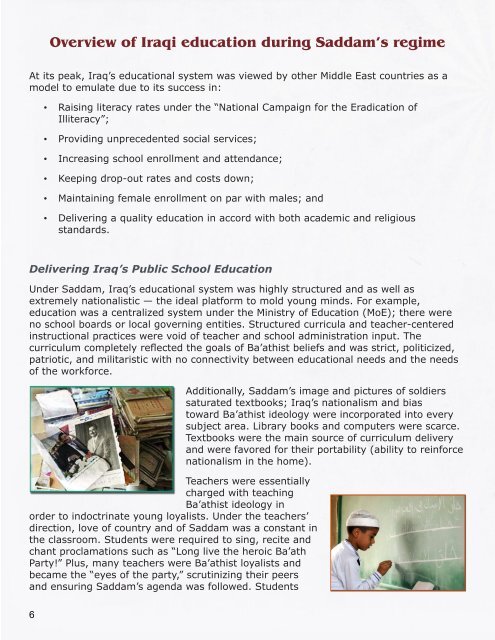Siovana el-Nashir - Final Project Booklet
Create successful ePaper yourself
Turn your PDF publications into a flip-book with our unique Google optimized e-Paper software.
Overview of Iraqi education during Saddam’s regime<br />
At its peak, Iraq’s educational system was viewed by other Middle East countries as a<br />
mod<strong>el</strong> to emulate due to its success in:<br />
• Raising literacy rates under the “National Campaign for the Eradication of<br />
Illiteracy”;<br />
• Providing unprecedented social services;<br />
• Increasing school enrollment and attendance;<br />
• Keeping drop-out rates and costs down;<br />
• Maintaining female enrollment on par with males; and<br />
• D<strong>el</strong>ivering a quality education in accord with both academic and r<strong>el</strong>igious<br />
standards.<br />
D<strong>el</strong>ivering Iraq’s Public School Education<br />
Under Saddam, Iraq’s educational system was highly structured and as w<strong>el</strong>l as<br />
extrem<strong>el</strong>y nationalistic — the ideal platform to mold young minds. For example,<br />
education was a centralized system under the Ministry of Education (MoE); there were<br />
no school boards or local governing entities. Structured curricula and teacher-centered<br />
instructional practices were void of teacher and school administration input. The<br />
curriculum complet<strong>el</strong>y reflected the goals of Ba’athist b<strong>el</strong>iefs and was strict, politicized,<br />
patriotic, and militaristic with no connectivity between educational needs and the needs<br />
of the workforce.<br />
Teachers were essentially<br />
charged with teaching<br />
Ba’athist ideology in<br />
order to indoctrinate young loyalists. Under the teachers’<br />
direction, love of country and of Saddam was a constant in<br />
the classroom. Students were required to sing, recite and<br />
chant proclamations such as “Long live the heroic Ba’ath<br />
Party!” Plus, many teachers were Ba’athist loyalists and<br />
became the “eyes of the party,” scrutinizing their peers<br />
and ensuring Saddam’s agenda was followed. Students<br />
Additionally, Saddam’s image and pictures of soldiers<br />
saturated textbooks; Iraq’s nationalism and bias<br />
toward Ba’athist ideology were incorporated into every<br />
subject area. Library books and computers were scarce.<br />
Textbooks were the main source of curriculum d<strong>el</strong>ivery<br />
and were favored for their portability (ability to reinforce<br />
nationalism in the home).<br />
learned via rote memorization (without understanding) and recitation.<br />
Differentiated instruction did not exist and critical thinking, discussion,<br />
creativity, and debating were not encouraged. Students and teachers had<br />
limited interactions.<br />
Saddam, a Sunni, required that only the Sunni interpretation of the Quran<br />
be taught, much to the chagrin of Shiite students and parents. Parents<br />
adopted a hands-off approach to their children’s education for fear of riling<br />
teachers and school administrators and being blacklisted as unpatriotic.<br />
The MoE, in collaboration with Iraq’s universities, produced teacher<br />
training videos, pamphlets, and t<strong>el</strong>evision programs designed not only to<br />
enhance teachers’ knowledge and skills within their specific subjects but<br />
also to accurat<strong>el</strong>y reflect Iraq’s views on education. Specially:<br />
1) The education reform process must be based on objective study and evaluation<br />
of the current situation, and a precise diagnosis of the problems of the current<br />
system and the obstacles facing reform and rebuilding.<br />
2) In order to guarantee the participation of all sectors of Iraqi society in the reform<br />
process, the responsibility of reforming the education system must extend beyond<br />
the MoE and its institutions.<br />
3) All decisions concerning reform of the curriculum must be strictly Iraqi and in<br />
line with Iraqi values and culture.<br />
USAID supports curriculum reforms primarily favoring math and science over social<br />
studies and other subjects that might cause cultural conflict.<br />
With the assistance of US and international aid<br />
groups, some curriculum changes were immediat<strong>el</strong>y<br />
implemented while others remained intact. For<br />
instance, new textbooks were printed and distributed<br />
without Saddam’s image. Also omitted were<br />
references to the Ba’athist ideology and politics as<br />
w<strong>el</strong>l as both Saddam’s and George Bush’s names.<br />
Militaristic content was replaced with forward-thinking,<br />
democratic language that espoused peace, human<br />
rights, and love of country and community while<br />
“un-demonizing” the US. Civics books mention Iraq’s<br />
turbulent history but in a carefully-worded and limited capacity.<br />
Baccalaureate exams are still an important benchmark and are conducted at the end of<br />
the 6th year, and at the end of the 9th and 12th years. R<strong>el</strong>igion continues to be taught<br />
to both Muslims and Christians separat<strong>el</strong>y; however, Shiite students are taught by Shiite<br />
teachers and Sunni children by Sunni teachers.<br />
Despite these changes to the curriculum, there still exist some challenges:<br />
• Not all of the country’s schools have received the new textbooks. Old materials<br />
(with Saddam’s image torn out) are being used, which creates problems in<br />
presenting updated material.<br />
6 7


